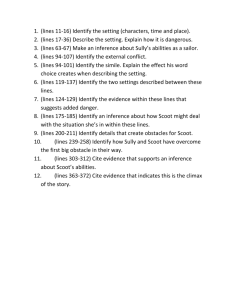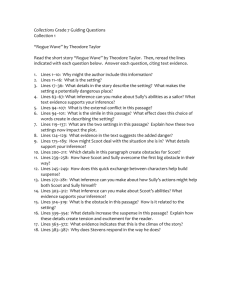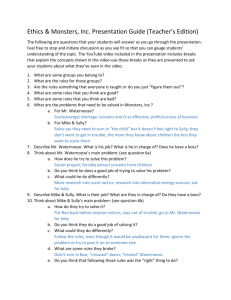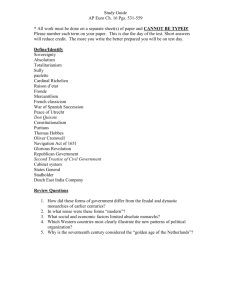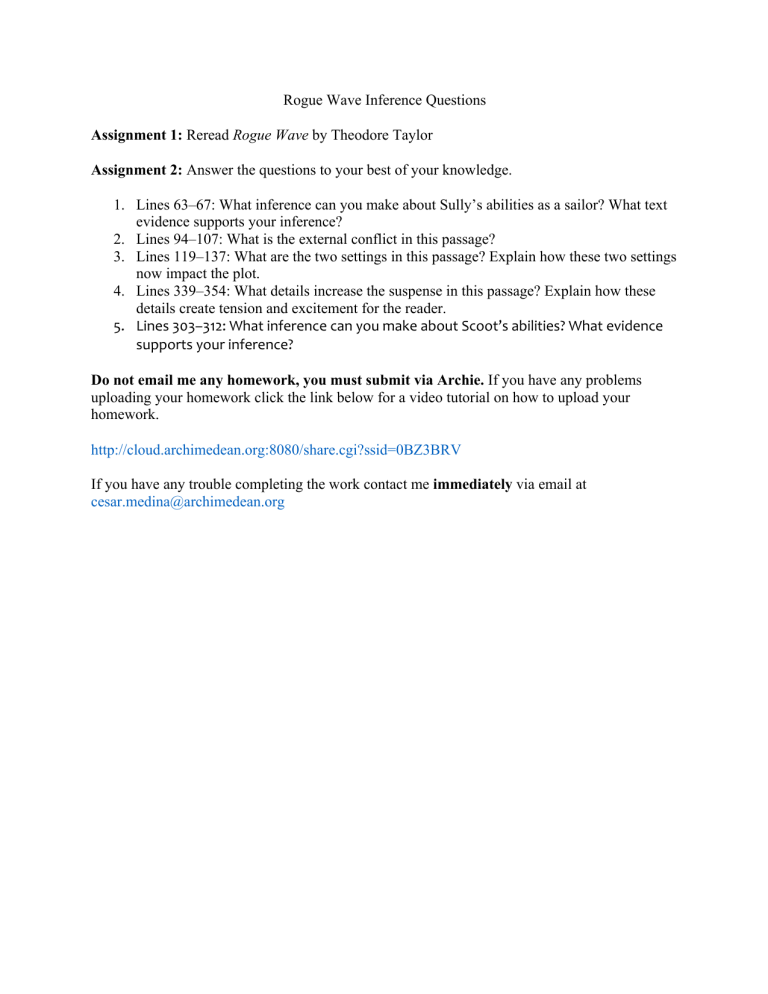
Rogue Wave Inference Questions Assignment 1: Reread Rogue Wave by Theodore Taylor Assignment 2: Answer the questions to your best of your knowledge. 1. Lines 63–67: What inference can you make about Sully’s abilities as a sailor? What text evidence supports your inference? 2. Lines 94–107: What is the external conflict in this passage? 3. Lines 119–137: What are the two settings in this passage? Explain how these two settings now impact the plot. 4. Lines 339–354: What details increase the suspense in this passage? Explain how these details create tension and excitement for the reader. 5. Lines 303–312: What inference can you make about Scoot’s abilities? What evidence supports your inference? Do not email me any homework, you must submit via Archie. If you have any problems uploading your homework click the link below for a video tutorial on how to upload your homework. http://cloud.archimedean.org:8080/share.cgi?ssid=0BZ3BRV If you have any trouble completing the work contact me immediately via email at cesar.medina@archimedean.org Background This adventure story features a cutter-rigged sailboat. Cutter-rigged boats are small sailing yachts, each with a single mast for the main sail and smaller sails up front. Cutters can be equipped with a cabin that usually includes a small kitchen, called a galley. Author Theodore Taylor (1921–2006) wrote many stories about self-reliant characters who face great challenges. His best-known book, The Cay, depicts the struggles of a young shipwrecked sailor. Rogue Wave Short Story by Theodore Taylor (t) ©Don Romero/Romero Fine Portraiture SETTING A PURPOSE Pay attention to the details and events that make this story an adventure. As you read, think about how the author builds a sense of excitement and anticipation throughout the short story. 10 As you read, save new words to myWordList. A killer wave, known to mariners as a “rogue wave,” was approaching a desolate area of Baja California below Ensenada. It had been born off the east coast of Australia during a violent storm; it had traveled almost 7,000 miles at a speed of 20.83 miles an hour. Driven by an unusual pattern of easterly winds, it was a little over 800 feet in length and measured about 48 feet from the bottom of its trough to its crest. On its passage across the Pacific, it had already killed thirteen people, mostly fishermen in small boats, but also an entire French family of five aboard a 48-foot schooner . . . Melissa “Scoot” Atkins went below into the Old Sea Dog’s tiny galley, moving down the three steps of the companionway, closing the two solid entry doors behind her, always a good Rogue Wave 3 idea in offshore sailing. The three horizontal hatch boards that were on top of the doors were also firmly in place, securing the thirty-foot Baba type against sudden invasion of seawater. 20 30 Rogues and sneakers have been around since the beginning of the oceans, and the earliest sea literature makes note of “giant” waves. The U.S. Navy manual Practical Methods for Observing and Forecasting Ocean Waves says, “In any wave system, after a long enough time, an exceptional high one will occur. These monstrous out-sized waves are improbable but still possible and the exact time of occurrence can never be predicted.” Naval hydrography1 studies indicate that waves 15 to 25 feet high qualify for “sneaker” or “sleeper” status; the freak rogue is up to 100 feet or over. As waters slowly warm they seem to be occurring more frequently. In 1995 the Queen Elizabeth 2 (the QE2), the great British passenger liner, encountered a 95foot rogue south of Newfoundland. More than 900 feet long, the QE2 rode over it, but her captain said it looked like they were sailing into the White Cliffs of Dover. Sullivan Atkins, Scoot’s oldest brother, was steering the cutter-rigged boat on a northerly course about fifteen miles off desolate Cabo Colnett, south of Ensenada. Under a brilliant sun, the glittering blue Pacific rose and fell in long, slick swells, a cold light breeze holding steady. 40 50 Below deck Scoot was listening to Big Sandy & His Fly-Rite Boys doing “Swingin’ West,” and singing along with them while slicing leftover steak from last night’s meal. They’d grilled it on a small charcoal ring that was mounted outboard on the starboard side2 at the stern, trailing sparks into the water. The Sea Dog had every blessed thing, including a barbecue pit, she marveled. Scoot was learning how to be a deep-water sailor. She was fourteen years old and pretty, with dark hair. Though small in size, not even five feet, she was strong. She’d started off with eight-foot Sabots. On this trip, her first aboard the Sea Dog, she’d manned the wheel for most of the three days they’d been under way. She’d stood four-hour watches at night. Sully was a good teacher. 1 2 4 hydrography: the scientific description and analysis of the earth’s surface waters. outboard on the starboard side: positioned outside and on the right side of the boat. Collection 1 swell (sw≈l) n. A swell is a long, unbroken wave. deck (d≈k) n. The deck is the platform on a ship or boat where people stand. 60 70 80 90 It was one of those perfect days to be out, Sully thought: the three Dacron sails belayed and whispering, white bow waves singing pleasant songs as the fiberglass hull, tilting to starboard, sliced through the ocean. It was a day filled with goodness, peace, and beauty. They’d come south as far as Cabo Colnett, turning back north only an hour ago. They’d sailed from Catalina Island’s Avalon Harbor, the Sea Dog’s home port, out in the channel off Los Angeles. Sully had borrowed the boat from a family friend, Beau Tucker, a stockbroker with enough money to outfit it and maintain it properly. Built by Ta-Shing, of Taiwan, she was heavy and sturdy, with a teakwood deck and handsome teakwood interior, and the latest in navigation equipment. Sully had sailed her at least a dozen times. He’d been around boats, motor and sail, for many of his nineteen years. He thought the Old Sea Dog was the best, in her category, that he’d ever piloted. As he was about to complete a northeast tack, Sully’s attention was drawn to a squadron of seagulls diving on small fish about a hundred yards off the port bow, and he did not see the giant wave that had crept up silently behind the Sea Dog. But a split second before it lifted the boat like a carpenter’s chip, he sensed something behind him and glanced backward, toward the towering wall of shining water. It was already too late to shout a warning to Scoot so she could escape from the cabin; too late to do anything except hang on to the wheel with both hands; too late even to pray. He did manage a yell as the Sea Dog became vertical. She rose up the surface of the wall stern first and then pitch-poled violently, end over end, the bow submerging and the boat going upside down, taking Sully and Scoot with it, the fortyfoot mast, sails intact, now pointing toward the bottom. Scoot was hurled upward, legs and arms flying, her head striking the after galley bulkhead and then the companionway steps and the interior deck, which was now the ceiling. She instantly blacked out. Everything loose in the cabin was scattered around what had been the overhead. Water was pouring in and was soon lapping at Scoot’s chin. It was coming from a four-inch porthole that had not been dogged securely and a few other smaller points of entry. navigation (n√v´ ∆-g∑´ sh∂n) n. The navigation of a ship or boat is the act of guiding it along a planned course. submerge (s∂b-mûrg´) v. When something submerges, it becomes covered by water. porthole (pôrt´ h∫l) n. A porthole is a circular window on a boat or ship. Rogue Wave 5 100 Sully’s feet were caught under forestay sailcloth, plastered around his face, but then he managed to shove clear and swim upward, breaking water. He looked at the mound of upside-down hull, bottom to the sky, unable to believe that the fine, sturdy Sea Dog had been flipped like a cork, perhaps trapping Scoot inside. Treading water, trying to collect his thoughts, he yelled, “Scoot,” but there was no answer. Heart pounding, unable to see over the mound of the hull, he circled it, thinking she might have been thrown clear. But there was no sign of her. Maneuvering his body, he pulled on the handles. The doors were jammed. 110 He swam back to the point of cabin entry, took several deep breaths, and dove. He felt along the hatch boards and then opened his eyes briefly to see that the doors were still closed. She was still inside. Maneuvering his body, he pulled on the handles. The doors were jammed, and he returned to the surface for air. He knew by the way the boat had already settled that there was water inside her. Under usual circumstances, the hull being upright, there would be four feet, nine inches of hull below the waterline. There would be about the same to the cabin overhead, enabling a six-foot-person to walk about down there. Panting, blowing, Sully figured there was at least a threefoot air pocket holding the Sea Dog on the surface, and if Scoot hadn’t been knocked unconscious and drowned, she could live for quite a while in the dark chamber. How long, he didn’t know. 120 In the blackness, water continued to lap at Scoot’s chin. She had settled against what had been the deck of the galley alcove, her body in an upright position on debris. Everything 6 Collection 1 not tied down or in a locker was now between the overhead ribs. Wooden hatch covers3 from the bilges were floating in the water and the naked bilges were exposed. Just aft of her body, and now above it, was the small diesel engine as well as the batteries. Under the water were cans of oil, one of them leaking. Battery acid might leak, too. Few sailors could imagine the nightmare that existed inside the Sea Dog. Scoot’s pretty face was splashed with engine oil. 130 140 150 Over the next five or six minutes, Sully dove repeatedly, using his feet as a fulcrum, and using all the strength that he had in his arms, legs, and back, in an effort to open the doors. The pressure of the water defeated him. Then he thought about trying to pry the doors open with the wooden handle of the scrub brush. Too late for that, he immediately discovered. It had drifted away, along with Scoot’s nylon jacket, her canvas boat shoes—anything that could float. Finally he climbed on top of the keel, catching his breath, resting a moment, trying desperately to think of a way to enter the hull. Boats of the Baba class, built for deep-water sailing, quite capable of reaching Honolulu and beyond, were almost sea-tight unless the sailors made a mistake or unless the sea became angry. The side ports were supposed to be dogged securely in open ocean. Aside from the cabin doors, there was no entry into that cabin without tools. He couldn’t very well claw a hole through the inch of tough fiberglass. He thought about the hatch on the foredeck, but it could only be opened from inside the cabin. Then there was the skylight on the top of the seventeen-foot cabin, used for ventilation as well as a sun source; that butterfly window, hinged in the middle, could be opened only from the inside. Even with scuba gear, he couldn’t open that skylight unless he had tools. He fought back tears of frustration. There was no way to reach Scoot. And he knew what would happen down there. The water would slowly and inevitably rise until the air pocket was only six inches; her head would be trapped between the surface of the water and the dirty bilge. The water would torture her, then it would drown her. Seawater has no heart, 3 Wooden hatch covers: door-like coverings made of wood that fit over openings on the deck or hull of a boat. Rogue Wave 7 160 170 180 190 no brain. The Sea Dog would then drop to the ocean floor, thousands of feet down, entombing her forever. Maybe the best hope for poor Scoot was that she was already dead, but he had to determine whether she was still alive. He began pounding on the hull with the bottom of his fist, waiting for a return knock. At the same time, he shouted her name over and over. Nothing but silence from inside there. He wished he’d hung on to the silly scrub brush. The wooden handle would make more noise than the flesh of his fist. Almost half an hour passed, and he finally broke down and sobbed. His right fist was bloody from the constant pounding. Why hadn’t he gone below to make the stupid sandwiches? Scoot would have been at the wheel when the wave grasped the Sea Dog. His young sister, with all her life to live, would be alive now. They’d had a good brother-sister relationship. He’d teased her a lot about being pint-sized and she’d teased back, holding her nose when he brought one girl or another home for display. She’d always been spunky. He’d taken her sailing locally, in the channel, but she’d wanted an offshore cruise for her fourteenth birthday. Now she’d had one, unfortunately. Their father had nicknamed her Scoot because, as a baby, she’d crawled so fast. It was still a fitting name for her as a teenager. With a wiry body, she was fast in tennis and swimming and already the school’s champion in the hundredyard dash. Eyes closed, teeth clenched, he kept pounding away with the bloody fist. Finally he went back into the ocean to try once more to open the doors. He sucked air, taking a half-dozen deep breaths, and then dove again. Bracing his feet against the companionway frames, he felt every muscle straining, but the doors remained jammed. He was also now aware that if they did open, more water would rush in and he might not have time to find Scoot in the blackness and pull her out. But he was willing to take the gamble. Scoot awakened as water seeped into her mouth and nose. For a moment she could not understand where she was, how she got there, what had happened …Vaguely, she remembered the boat slanting steeply downward, as if it were suddenly diving, and she remembered feeling her body going up. 8 Collection 1 200 210 That’s all she remembered, and all she knew at the moment was that she had a fierce headache and was in chill water in total darkness. It took a little longer to realize she was trapped in the Sea Dog’s cabin, by the galley alcove. She began to feel around herself and to touch floating things. The air was thick with an oil smell. Then she ran her hand over the nearest solid thing—a bulkhead. That’s strange, she thought—her feet were touching a pot. She lifted her right arm and felt above her—the galley range. The galley range above her? The boat was upside down. She felt for the companionway steps and found the entry doors and pushed on them; that was the way she’d come in. The doors didn’t move. Sully crawled up on the wide hull again, clinging to a faint hope that a boat or ship would soon come by; but the sun was already in descent, and with night coming on, chances of rescue lessened with each long minute. It was maddening to have her a few feet away and be helpless to do anything. Meanwhile the hull swayed gently, in eerie silence. 220 Scoot said tentatively, “Sully?” Maybe he’d been drowned. Maybe she was alone and would die here in the foul water. She repeated his name, but much more loudly. No answer. She was coming out of shock now and fear icier than the water was replacing her confusion. To die completely alone? It went that way for a few desperate moments, and then she said to herself, Scoot, you’ve got to get out of here! There has to be some way to get out . . . 9 230 Sully clung to the keel with one hand, his body flat against the smooth surface of the hull. There was ample room on either side of the keel before the dead-rise, the upward slope of the hull. The Sea Dog had a beam of ten feet. Unless a wind and waves came up, he was safe enough in his wet perch. Scoot again wondered if her brother had survived and if he was still around the boat or on it. With her right foot she began to probe around the space beneath her. The pot had drifted away, but her toes felt what seemed to be flatware. That made sense. The drawer with the knives and forks and spoons had popped out, spilling its contents. She took a deep breath and ducked under to pick out a knife. Coming up, she held the knife blade, reaching skyward with the handle . . . 240 Eyes closed, brain mushy, exhausted, Sully heard a faint tapping and raised up on his elbows to make sure he wasn’t dreaming. No, there was a tapping from below. He crawled back toward what he thought was the source area, the galley area, and put an ear to the hull. She was tapping! He pounded the fiberglass, yelling, “Scoot, Scooot, Scooot . . .” Scoot heard the pounding and called out, “Sully, I’m here, I’m here!” Her voice seemed to thunder in the air pocket. Sully yelled, “Can you hear me?” Scoot could only hear the pounding. “Help me out of here . . .” 250 Ear still to the hull, Sully shouted again, “Scoot, can you hear me?” No answer. He pounded again and repeated, “Scoot, can you hear me?” No answer. The hull was too thick and the slop of the sea, the moan of the afternoon breeze, didn’t help. Though she couldn’t hear his voice, the mere fact that he was up there told her she’d escape. Sully had gotten her out of jams before. There was no one on earth that she’d rather have as a rescue man than her oldest brother. She absolutely knew she’d survive. 260 10 Though it might be fruitless, Sully yelled down to the galley alcove, “Listen to me, Scoot. You’ll have to get out by yourself. I can’t help you. I can’t break in. Listen to me, I know you’re in water, and the best way out is through the skylight. You’ve got Collection 1 to dive down and open it. You’re small enough to go through it . . .” She could go through either section of the butterfly window. “Tap twice if you heard me!” She did not respond, and he repeated what he’d just said, word for word. No response. No taps from below. 270 Scoot couldn’t understand why he didn’t just swim down and open the doors to the cabin, release her. That’s all he needed to do, and she’d be free. No response. No taps from below. 280 290 Sully looked up at the sky. “Please, God, help me, help us.” It was almost unbearable to know she was alive and he was unable to do anything for her. Then he made the decision to keep repeating: “Listen to me, Scoot. You’ll have to get out by yourself. I can’t break in. Listen to me, the best way out is through the skylight. You’ve got to dive down and open it. You’re small enough to go through it . . .” He decided to keep saying it the rest of the day and into the night or for as long as it took to penetrate the hull with words. Skylight! Skylight! Over and over. He’d heard of mental telepathy but had not thought much about it before. Now it was the only way to reach her. Scoot finally thought that maybe Sully was hurt, maybe helpless up on that bottom, so that was why he couldn’t open the doors and let her out. That had to be the reason—Sully up there with broken legs. So I’ll have to get out on my own, she thought. Over the last two days, when she wasn’t on the wheel she had been exploring the Sea Dog, and she thought she knew all the exits. Besides the companionway doors, which she knew she couldn’t open, there was the hatch on the foredeck for access to the sails; then there was the skylight, almost Rogue Wave 11 in the middle of the long cabin. Sully had opened it, she remembered, to air out the boat before they sailed. As she clung to a light fixture by the alcove, in water up to her shoulders, something kept telling her she should first try the butterfly windows of the skylight. The unheard message was compelling—Try the skylight. 300 310 320 Sully’s voice was almost like a recording, a mantra, saying the same thing again and again, directed down to the position of the galley. Scoot remembered that an emergency flashlight was bracketed on the bulkhead above the starboard settee, and she assumed it was waterproof. From what Sully had said, Beau Tucker took great care in selecting emergency equipment. It might help to actually see the dogs on the metal skylight frame. She knew she wouldn’t have much time to spin them loose. Maybe thirty or forty seconds before she’d have to surface for breath. Trying to think of the exact position of the upside-down flashlight, she again tapped on the hull to let her brother know she was very much alive. He pounded back. Sully looked at his watch. Almost four-thirty. About three hours to sundown. Of course, it didn’t make much difference to Scoot. She was already in dank night. But it might make a difference if she got out after nightfall. He didn’t know what kind of shape she was in. Injured, she might surface and drift away. The mantra kept on. Scoot dove twice for the boxy flashlight, found it, and turned it on, suddenly splitting the darkness and immediately feeling hopeful. But it was odd to see the Sea Dog’s unusual overhead, the open hatchways into the bilge and the debris floating on the shining water, all streaked with lubricants; odd to see the toilet upside down. She held the light underwater and it continued to operate. 330 12 Every so often, Sully lifted his face to survey the horizon, looking for traffic. He knew they were still within sixteen or seventeen miles of the coast, though the drift was west. There was usually small-boat activity within twenty miles of the shore—fishermen or pleasure boats. Collection 1 Scoot worked herself forward a few feet, guessing where the skylight might be, and then went down to find the butterfly windows, the flashlight beam cutting through the murk. It took a few seconds to locate them and put a hand on one brass dog. She tried to turn it, but it was too tight for her muscles and she rose up to breathe again. 340 350 Not knowing what was happening below or whether Scoot was trying to escape, Sully was getting more anxious by the moment. He didn’t know whether or not the crazy telepathy was working. He wished she would tap again to let him know she was still alive. It had been more than twenty minutes since she’d last tapped. Scoot had seen a toolbox under the companionway steps and went back to try to find it. She guessed there’d be wrenches inside it, unless they’d spilled out. Using the flashlight again, she found the metal box and opened it. Back to the surface to breathe again, and then back to the toolbox to extract a wrench. With each move she was becoming more and more confident. A big sailboat, beating south, came into Sully’s view; but it was more than two miles away and the occupants—unless he was very lucky—would not be able to spot the Sea Dog’s mound and the man standing on it, waving frantically. Four times Scoot needed to dive, once for each dog; and working underwater was at least five times as difficult as trying to turn them in usual circumstances. She’d aim the light and rest it to illuminate the windows. Finally, all the dogs Rogue Wave 13 360 were loose and she rose once again. This time, after filling her lungs to bursting, she went down and pushed on the starboard window. It cracked a little, but the outside sea pressure resisted and she had to surface again. Sully sat down, almost giving up hope. How long the air pocket would hold up was anybody’s guess. The boat had settled at least six inches in the last two hours. It might not last into the night. 370 380 390 On her sixth dive Scoot found a way to brace her feet against the ceiling ribs. She pushed with all her strength, and this time the window opened. Almost out of breath, she quickly pushed her body through and the Old Sea Dog released her. Treading water beside the hull, she sucked in fresh air and finally called out, “Sully …” He looked her way, saw the grin of triumph on the oil-stained imp face, and dived in to help her aboard the derelict. Shivering, holding each other for warmth all night, they rode and rocked, knowing that the boat was sinking lower each hour. Just after dawn, the Red Rooster, a long-range sports fishing boat out of San Diego bound south to fish for wahoo and tuna off the Revilla Gigedo Islands, came within a hundred yards of the upside-down sailboat and stopped to pick up its two chattering survivors. The Red Rooster’s captain, Mark Stevens, asked, “What happened?” “Rogue wave,” said Sully. That’s what he planned to say to Beau Tucker as well. Stevens winced and nodded that he understood. The Old Sea Dog stayed on the surface for a little while longer, having delivered her survivors to safety; then her air pocket breathed its last and she slipped beneath the water, headed for the bottom. COLLABORATIVE DISCUSSION How and when did this adventure tale “hook” you? As it unfolded, what events helped to keep you anxious about what would happen? With a partner, review “Rogue Wave” to point out and discuss the parts that helped to create excitement and anticipation. 14 Collection 1
